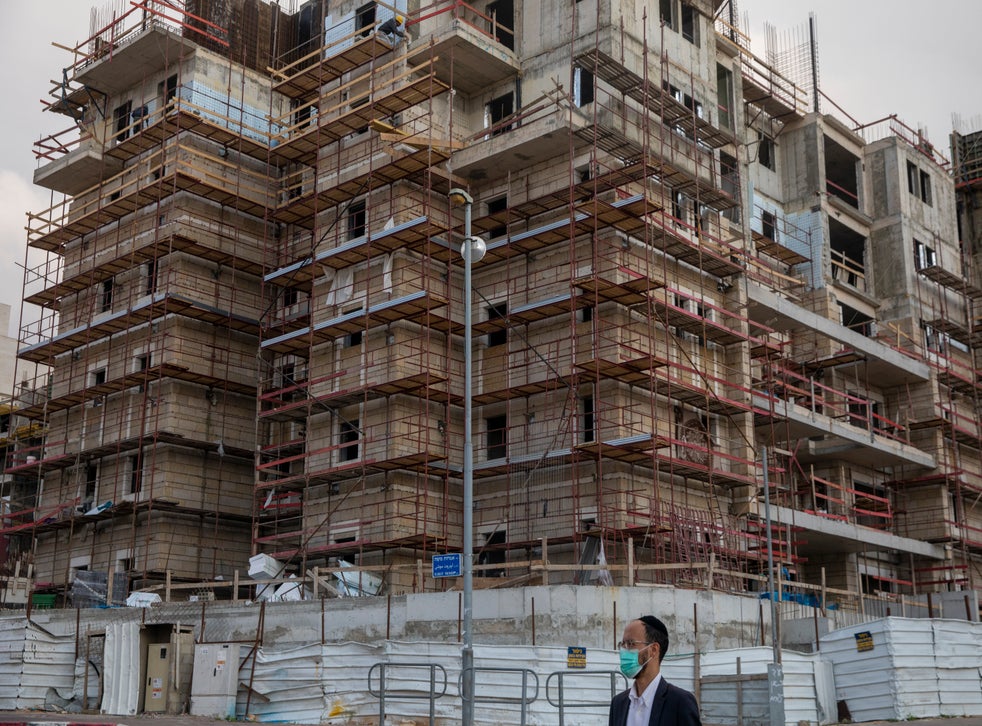
After thousands of Trump supporters rally in D.C., violence erupts when night falls
President Trump’s supporters had celebrated for hours on Saturday, waving their MAGA flags and blaring “God Bless the U.S.A.” as they gathered in Washington to falsely claim that the election had been stolen from the man they adore. The crowd had even reveled in a personal visit from Trump, who passed by in his motorcade, smiling and waving.
VIDEO Trump supporters and far-right groups take to the streets of D.C.
But that was before the people who oppose their hero showed up and the mood shifted, growing angrier as 300 or so counterprotesters delivered a message the president’s most ardent backers were unwilling to hear: The election is over. Trump lost.
On stark display in the nation’s capital were two irreconcilable versions of America, each refusing to accept what the other considered to be undeniable fact.
While much of the day unfolded peacefully, brief but intense clashes erupted throughout. Activists spewed profanity and shouted threats, threw punches and launched bottles. On both sides, people were bloodied, and at least 20 were arrested, including four whose allegiances remain unknown on gun charges. The chaos also left two officers injured.

VIDEO Protesters clash as night falls in D.C.
When darkness fell, the counterprotesters triggered more mayhem as they harassed Trump’s advocates, stealing red hats and flags and lighting them on fire. Scuffles continued into the night as the provocateurs overturned the tables of vendors who had been selling pro-Trump gear and set off dozens of fireworks, prompting police to pepper-spray them.
At 8 p.m., violence broke out five blocks east of the White House between the president’s supporters, who wielded batons, and his black-clad detractors, many of whom had participated in racial justice rallies throughout the summer. As the groups approached the same intersection, they charged each other, brawling for several minutes before police arrived and cleared the area.
In the melee, a D.C. fire official said, a man in his 20s was stabbed in the back and taken to the hospital with serious injuries.
Hours later, with midnight approaching, a group of marchers unfurled a massive “TRUMP LAW AND ORDER” banner and laid it atop Black Lives Matter Plaza. Afterward, they carried it as close as they could get to a White House barricaded behind rows of high steel fencing.
The daytime demonstrations were urged on by Trump, who refuses to concede to Joe Biden or allow a formal transition to begin. On Saturday morning, as the president’s devotees remained in D.C. to fight for him, he headed to Trump National Golf Club in the Virginia suburbs for a round.

VIDEO Trump supporters in D.C. cheer as president's motorcade rushes by
After a week in which more than 750,000 Americans were diagnosed with the novel coronavirus, almost none of his backers wore masks. Among their ranks were white nationalists, conspiracy theorists and far-right activists carrying signs demanding action that was already being taken: “Count the legal votes.”
Trump had thrilled them when his motorcade appeared on Pennsylvania Avenue shortly after 10 a.m., prompting fans to scramble to the side of Freedom Plaza to catch a glimpse.
“He drove right past me. I saw him. He waved right past me,” one man said as he tried to collect himself.
A group of women huddled around a phone, looking at a video of Trump’s appearance near a Walt Whitman quote inscribed in the stone beneath them: “The President is there in the White House for you, it is not you who are here for him.”

© Matt McClain/The Washington Post
People wave to President Donald Trump's motorcade Saturday as it drives past Freedom Plaza as supporters gathered for the Million MAGA March in D.C.
Then the appearance of counterprotesters sparked bursts of conflict, though they could have become far more violent had police not worked to keep the feuding sides separate. When a small group holding bright orange “Refuse Fascism” posters arrived at the edge of Freedom Plaza, they were almost immediately surrounded by Trump fans shouting “U.S.A.! U.S.A.!” into their faces.
The women leading the tiny march fought their way up 14th Street, repeatedly breaking out of the crowd, only to be engulfed again.
“Trump, pack your s---! You’re illegitimate!” they yelled into their megaphone.
One pro-Trump man attempted to gouge the opposition with a flag bearing the president’s name. Another grabbed a woman’s neon orange poster and hit her with it.
When the women made it to the barrier set up by police across the street, Trump supporters filled the entire intersection, blocking them. Police arrived on bikes and, after several minutes, moved the crowd back. Shortly after, the group began singing the national anthem.
Nearby, on the street beside inscriptions from Abraham Lincoln recognizing the District as a place of freedom, people piled atop a U-Haul truck with a flag of a gun and the words “Come and take it.”

© Toni L. Sandys/The Washington Post
A Trump supporter is pushed back by a DC Police officer after trying to make his way towards the crowd gathered at Black Lives Matter Plaza.
Later, near Union Station, another altercation broke out.
Roland Biser, a 69-year-old Pentagon employee who had attended a pro-Trump rally, was driving home when he said he saw a young man throw a rock at a group of Trump supporters. The rock grazed a woman, he said, and may have hit someone else.
Biser pulled over as a crowd quickly surrounded the young man and three others with him, all of whom were Black. Nearly a hundred Trump supporters quickly surrounded them before a dozen U.S. Capitol Police officers rushed in and separated the groups.
As police escorted the four young men away, the crowd taunted them, chanting “U.S.A.!”
“I didn’t do anything!” said one of them, who had been handcuffed. The 21-year-old D.C. resident insisted that it was the Trump supporters who had come after him.
A few minutes later, police removed the cuffs off and let him go.

© Matt McClain/The Washington
Post Trump supporters face off with counter protesters along 14th Street in downtown D.C. during the Million MAGA March.
A family of four on Capital Bikeshare bikes — the father with an American flag tied around his neck like a cape — were cut off by a line of counterprotesters as they tried to leave a tense scene outside the Supreme Court about 1 p.m.
“Get out of our city!” a young woman in black yelled.
“You lost, losers!” shouted a man.
The father and his teenage son began to chant “U.S.A.!” and raised their fists as police officers surrounded the family and pushed them out of the crowd.
“Why would you bring your kids here? It’s dangerous,” observed a man nearby, a helmet on his head and respirator hanging around his neck.
On a day when the president’s supporters touted a vast array of falsehoods, his spokeswoman, Kayleigh McEnany, offered perhaps the most ludicrous.
“More than one MILLION marchers for President @realDonaldTrump descend on the swamp in support,” she tweeted, vastly exaggerating the crowd size.
Hours before the official rally began, the Trump believers had started gathering Saturday morning at Freedom Plaza.
“They think we’re stupid,” a young White man with a microphone told the crowd. “They’re underestimating The Donald. They’re underestimating The Donald’s supporters.”
“They’re stupid!” a young White woman replied.
Speakers who addressed the aggrieved legions included Alex Jones, a discredited conspiracy theorist most famous for tormenting the families of school shooting victims, and Marjorie Taylor Greene, a recently elected congresswoman from Georgia who has promoted QAnon, which falsely alleges that famous Democrats belong to a cabal of Satan-worshiping pedophiles.

Proud Boys march outside Freedom Plaza in Washington to protest the election results. (Photo by Evelyn Hockstein/For The Washington Post)
Among the rallygoers were members of the Proud Boys, an extremist group known for their black-and-yellow garb and endorsements of violence. Some wore flak jackets and helmets. “Stand Back, Stand By,” read several of their shirts, referencing the president’s directive to them during a September debate.
As conservative speakers at Freedom Plaza derided the news media, including Fox News, the Proud Boys marched down Pennsylvania Avenue, leading hundreds in chants of “F--- antifa!” and shouting down stray opponents who yelled “Black lives matter!”
“All lives matter!” they screamed back.
Marching with them was D.C. resident Justin Anthony, who waved a satirical sign that read, “Sue anyone who did not vote for this great American.”
He led chants to the tune of “Count only Trump votes” and danced around in a large mock police uniform with the name “Officer Pudge” on its badge.
Almost no one got it, he said. They joined in, asked for pictures, cheered.
“It’s crazy,” he said. “Like, they really don’t see how insane this is.”
Near the Supreme Court, a line of riot police stood facing a few dozen protesters resting homemade shields on the ground as a MAGA throng chanted and churned behind them.
“F--- antifa!” they shouted in unison.
“Who’s antifa?” one Trump supporter wondered.
“I don’t know,” another responded. “But they don’t like her!”
Snippets of speeches from the court’s steps floated over the crowd between roaring cheers. Listeners climbed trees on the Capitol grounds, where they hung onto trunks and flipped off counterprotesters with their free hands.
A woman standing next to a barricade prayed over a well-worn Bible, an American flag sticking out of her purse.
On the other side of the police line, behind the line of homemade shields stamped with the letters BLM, a man with a cane also hunched over a book: “Black Reconstruction in America,” by W.E.B. Du Bois.
At midday, along the east end of Freedom Plaza, a lone counterprotester stood on the sidewalk holding a sign that read “Trump is the fraud.” He wore a gray cloth mask.
A succession of Trump supporters approached the curb, unmasked, to offer their opinions of his solitary demonstration.
“Why didn’t your mother abort you?” one screamed. “You’re mentally disturbed, and you’re a coward, and you’re a f-----. I hope you get AIDS."
“I just feel strongly about the disinformation that’s being peddled on the Internet about fraud in this election,” said the counterprotester, a 40-year-old D.C. man who declined to give his name because he is a federal employee and feared repercussions at work.
As a thin film of sweat formed on his face, an elderly woman in red MAGA gear paused and stared at him sadly.
“We feel bad for you that you can’t see the truth,” she said.
“I feel the same way about you,” he replied.
Marissa Lang, Michael Miller, Peter Jamison, Justin Wm. Moyer, Clarence Williams, Peter Hermann, Fredrick Kunkle, John Woodrow Cox Moriah Balingit, Julie Zauzmer, Katie Mettler, Rachel Chason, Emily Davies, Michael Brice-Saddler and David Nakamura contributed to this report.
MAGA March: Trump supporters, far-right leaders and counterprotesters meet in Washington
Anti-Trump protesters clashed with supporters of the President and law enforcement Saturday evening in the nation's capital as they tried to make their way to a hotel where Trump supporters were staying.
© Jacquelyn Martin/AP
With the U.S. Capitol in the background, supporters of President Donald Trump rally at Freedom Plaza, Saturday Nov. 14, 2020, in Washington.
By Julia Jones and Sara Sidner, CNN
At least 20 people were arrested, according to LaToya Foster, a spokesperson for DC Mayor Muriel Bowser. Foster said two officers with the DC Metropolitan Police were injured.
The skirmishes came after a day of largely peaceful demonstrations by thousands of President Donald Trump's supporters of all stripes, including right-wing and far-right groups, to protest the election results
Smaller groups of counter demonstrators gathered downtown and near the Supreme Court in support of President-elect Joe Biden's electoral victory -- which the President has falsely described as fraudulent.
Many groups that attended the planned rallies have distinct core beliefs, but on Saturday were united in their unwavering support for the President. They included anti-government groups such as the Oath Keepers, far-right groups such as the Proud Boys and the Three Percenters, conspiracy theorists such as Alex Jones and Republican members of Congress.
Word of at least three different pro-Trump events circulated on social media in recent days -- "Stop the Steal," "March for Trump" and "Million MAGA March." Throngs began pouring into Freedom Plaza, just east of The White House, hours before the noontime events.
Organizers for the "March for Trump" event -- which obtained the permit for the rally -- did not respond to CNN's requests for comment.
Trump took notice of the gatherings and tweeted on Friday that he might make an appearance. Before Saturday's rallies, the President's motorcade passed cheering and waving supporters on his way to a golf outing.
Mainstream conservative voices and elected officials such as Rep. Paul Gosar of Arizona and Rep. Mike Kelly of Pennsylvania were advertised as speakers for the "March for Trump" event.
The "Million MAGA March" announced its notable attendees would include conspiracy theorists and others like podcaster Nick Fuentes, who participated in the deadly 2017 Charlottesville "Unite the Right" rally, and Mike Cernovich, who pushed the "pizza gate" conspiracy theory.
Leadership and members of the Proud Boys, a far-right group that Trump asked to "stand back and stand by" during the first of two 2020 presidential debates, were in attendance.
Ben Hovland, a senior federal election security official appointed by Trump, has called the President's accusations of a rigged election "insulting" and "laughable."
© Julio Cortez/AP
Throngs of President Donald Trump supporters poured into Freedom Plaza during demonstration.
While there had been warnings of potential violence, the daytime activities were mostly peaceful, without any major incidents.
To those who have been tracking far right and extremist groups for years, Saturday's rally illustrates the thinning of a line between the mainstream right and far-right extremists.
Oren Segal, vice president of the Anti-Defamation League's Center on Extremism, said he expected the vast majority of participants to be there solely to show their support for Trump, but the event was an opportunity for extremists to be mingling with that demographic.
"There's a platform there, there are pro-Trump supporters and conservatives, and people who want to express their support for this President, who are going to be mingling, if you will, with extremists," Segal said.
Just as misinformation about the elections made its way from fringe platforms into the Twitter feeds of the President's inner circle, Segal feared the Saturday march could have been its physical manifestation, spreading not only wrong information but hateful, extremist rhetoric.
"The fact that this sort of space is attracting those who buy into this idea that something is being stolen and taken away, and that extremists may be adjacent to them is a concern more broadly of the normalization of the extremists and of what could happen when you get a bunch of people together who are upset."
© Leah Millis/Reuters
Throngs of "Stop the Steal" protesters gathered in Washington, DC

























